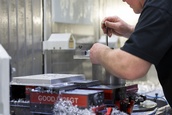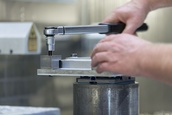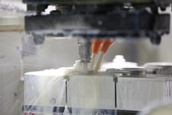Milling
Milling describes the working of metals, wood, or plastics by removing cuttings with a milling tool. This is usually done on a milling machine, a milling center or a machining center. This method differs from turning in that here the work piece is clamped on the machine table, and the cutting movement for removing material is produced by rotating the cutting tool – also called a milling tool – opposite the work piece. The advance movement for shaping is achieved depending on the type, either by displacement of the machine table or by moving the milling tool around the work piece. Advance movements, depending on the design, can be combined in the X-, Y-, and Z-axis or along the respective axes of rotation.
The milling tool movement type relative to the work piece is what distinguishes face milling, roll milling and 3D milling.
In face milling, also called end milling, the axis of the milling cutter is at a right angle to the surface being machined; the material is removed using the frontal surface of the milling tool.
By contrast, in roll milling or peripheral or contour milling, the axis of the tool is parallel to the surface to be milled; the material is removed by the outer surface of the tool. Depending on the feed direction, in this machining type we differentiate between down milling and up-milling. Down milling is used preferentially on stabile, backlash-free machines as better surfaces are obtained. If the stability of the machine is insufficient, recourse is made to up-milling.
In 3D milling, milling cutters with a spherical end, so-called full-radius milling cutters full-radius milling machines, are used. Here spherical cutting removes the material, which makes it possible to produce three-dimensional shapes. 3D machining is used predominantly in mold making, because it is very time-consuming and is as a rule too expensive for serial production.




